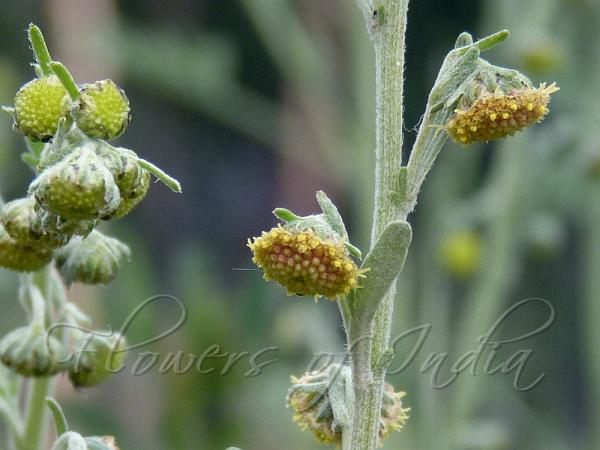|
| Large-Flowered Wormwood |
|

|

| File size | 146113 |
| Original date | 6/25/12 4:42 PM |
| Resolution | 1000 x 750 |
| Flash | Flash did not fire, auto |
| Focal length | 15.8mm |
| Exposure time | 1/125s |
| Aperture | 4.0 |
| Focus Distance | |
| Metering Mode | Multi-segment |
| Camera make | Panasonic |
| Camera model | DMC-FZ40 |
| Sensor type | OneChipColorArea |
|
|
|
|
Photo: |
Botanical name: Artemisia macrocephala Family: Asteraceae (Sunflower family)
Synonyms: Artemisia akbaitalensis, Artemisia griffithiana, Artemisia sieversiana var. pygmaea
Synonyms: Artemisia akbaitalensis, Artemisia griffithiana, Artemisia sieversiana var. pygmaea
Large-Flowered Wormwood is an annual herb, up to
20-30 cm tall, densely whitish-grey hairy, with 6-8 cm long, well
branched root. Stems are several from the base or solitary, erect to
ascending, ribbed, with 1.5-3 cm long internodes. Basal and lower stem
leaves are carried on 1.5-3 cm long, winged stalks. Leaves are broadly
ovate to round, 1.0-1.5 x 1.0-1.5 cm, bipinnately cut into
linear-oblanceolate, 2.5- 4 x 0.5-1 mm, apically obtuse ultimate
segments; medium and upper stem leaves subsessile to sessile, gradually
reduced in size. Flower-heads are remote, in simple, 10-12 cm long
racemes, hemispherical, usually 0.6-1 cm across, nodding. Lower
peduncles are slender, 8-12 mm long, upper ones smaller, curved.
Involucre 4-seriate, outermost phyllaries linear-oblong, (3-) 4-5 mm
long, densely hairy, obtuse; median phyllaries narrowly obovate, 3-4 x
1.5-2 mm, green and densely hairy to glabrescent on midrib,
scarious-membranous alround; innermost elliptic-obovate, 3.5-4.5 x
1.75-2.5 mm, obtuse, scarious, glabrous. Receptacle is hemispherical,
2.5-3 mm in diameter, densely hairy. Florets are numerous, all fertile,
greenish-yellow; marginal florets female, eligulate, with c. 1.5 mm
long, 2-toothed, basally broadened, glandular corolla, style branches
exserted; disc-florets bisexual, with 5-toothed, densely glandular, c.
2 mm long, tubular corolla, anther appendages acute, protruding.
Cypselas narrowly oblanceolate, 1-1.5 mm long, light brown.
Large-Flowered Wormwood is found in China, Mongolia, Tibet, Russia,
India, Pakistan and Afghanistan, at altitudes of 3400-5500 m.
Flowering: June-September.
| Identification credit: Prashant Awale, Miroslav Dvorsky | Photographed in Ladakh. |
• Is this flower misidentified? If yes,